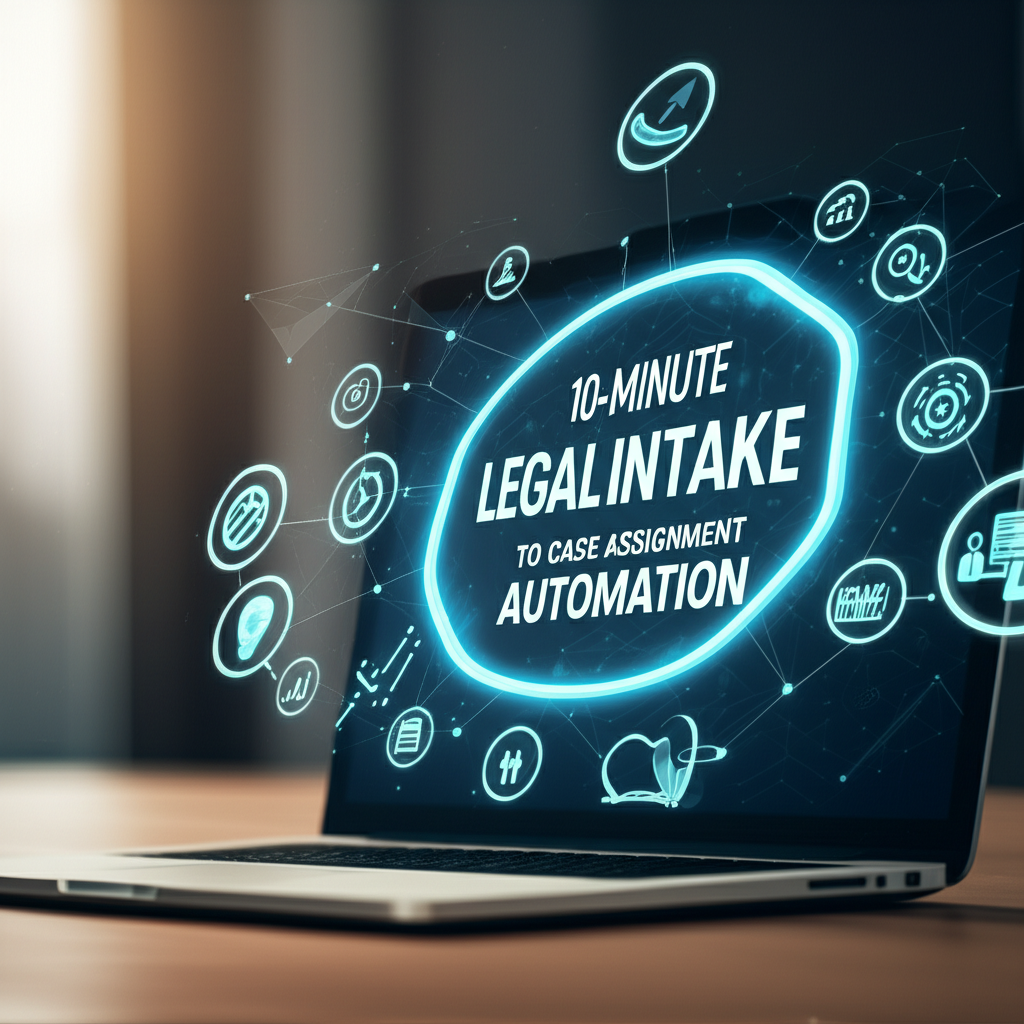End-to-End Workflow: From Client Inquiry to Case Assignment in Under 10 Minutes
Client expectations and regulatory pressures are rising, while margins tighten. The firms and legal departments thriving today share one advantage: they automate repeatable intake and triage. By orchestrating Microsoft 365, Power Platform, and your existing legal systems, you can route inquiries, check conflicts, create a matter shell, and assign the right attorney—in under 10 minutes—while improving compliance and client service.
Table of Contents
- The 10-Minute Intake-to-Assignment Framework
- Client Onboarding & Communication Workflows
- Microsoft 365 & Power Platform Use Cases
- Case / Matter Management Automation
- Compliance & Risk Monitoring with Automation
- Integrating AI into Automated Workflows
- Walkthrough: Build a Power Automate Intake-to-Assignment Flow
- ROI & Business Case for Legal Automation
- Future Trends in Legal Process Automation
- Conclusion
The 10-Minute Intake-to-Assignment Framework
This framework shows how to transform a raw client inquiry into a matter-ready assignment quickly and defensibly. It relies on low-code building blocks (Forms/Power Apps, Power Automate, SharePoint/Dataverse, Teams/Planner, Outlook) plus policy controls (Purview DLP, retention labels) to standardize intake and ensure approvals where needed.
Inquiry → Identity & Consent → Conflict Pre-Screen → Route by Practice/Region → Provisional Matter Shell → Team/Folder Provisioning → Attorney Assignment → Client Confirmation
Key principles: minimize manual data entry, enforce approvals only where risk exists, and provision collaboration assets just-in-time.
Client Onboarding & Communication Workflows
Capture inquiries consistently across channels, reduce back-and-forth, and set expectations:
- Unified intake: Microsoft Forms or a Power Apps Portal as the preferred entry point; integrate with website, QR codes, email auto-responders, and a Teams/website chat bot.
- Disclosures: Present engagement disclaimers (no attorney-client relationship until confirmed), privacy notice, and consent to retain data; store the consent timestamp.
- Identity signals: Optional SMS/email verification or OAuth sign-in for corporate clients; flag high-risk geographies for additional review.
- Instant acknowledgment: Auto-send a branded receipt with next steps and an ETA. Offer self-service FAQs or scheduling links when appropriate.
Best practice: Design for “one-touch intake.” Ask only what you need to triage (names, entities, matter type, jurisdiction, urgency, conflicts list). Enrich data later in the case lifecycle to avoid friction and reduce data exposure.
Microsoft 365 & Power Platform Use Cases
Microsoft 365 is a powerful automation fabric for legal teams. You can combine standardized intake, automated checks, and instant collaboration—without custom code:
- Capture: Microsoft Forms or Power Apps to structure intake data.
- Orchestration: Power Automate for routing, approvals, escalations, and notifications.
- Data: SharePoint lists or Dataverse to store matter metadata with permissions and retention.
- Collaboration: Microsoft Teams templates, Planner (Tasks by Planner), and OneDrive/SharePoint libraries for matter workspaces.
- Control: Microsoft Purview for DLP, sensitivity labels, auto-retention, and eDiscovery.
- Insights: Power BI dashboards for intake volume, SLA adherence, and conversion rates.
| Process Step | Manual (Typical) | Automated with M365/Power Platform | Impact |
|---|---|---|---|
| Client Acknowledgment | Within hours via email | Instant receipt with SLA and next steps | Higher client confidence and conversion |
| Conflict Pre-Screen | Paralegal checks spreadsheets and emails | Automatic name screening and approval workflow | Faster triage; auditable decisions |
| Routing & Assignment | Coordinator emails practice leads | Rules-based routing by practice/region/capacity | Under 10 minutes; fewer bottlenecks |
| Matter Shell Creation | Manual folder and template setup | Automated Teams/site provisioning with templates | Consistency and reduced admin time |
| Compliance Logging | Scattered notes and email trails | Centralized log in SharePoint/Dataverse | Defensible record, easier audits |
Case / Matter Management Automation
Whether you use a legal practice management platform or a custom matter repository, automation can bridge intake and ongoing work:
- Matter metadata: Create a provisional matter record (client, entities, jurisdiction, practice area, risk rating, intake ID) in a SharePoint list or Dataverse table. Sync or push to your matter management system via API/connector.
- Workspace provisioning: Auto-generate a Microsoft Team (or SharePoint site) from a “Matter Template” with channels, tabs (Planner, OneNote, document library), and folder structure. Apply sensitivity labels to restrict external sharing when needed.
- Assignment: Auto-create a task in Planner for the lead attorney with due time under the 10-minute SLA and a one-click “Accept” button via Adaptive Card in Teams.
- Templates & documents: Attach standard engagement letters and KYC questionnaires from a template library, prefilled with intake metadata using content controls or modern document assembly tools.
Compliance & Risk Monitoring with Automation
Embedding compliance into the workflow reduces risk while accelerating decisions:
- Conflicts: Automatically screen party names against a conflicts dataset (from your matter system or a dedicated conflicts database). If a potential conflict is detected, trigger an approval to the conflicts committee with full context and a documented outcome.
- Privacy & security: Use Purview DLP policies to prevent PII from being emailed outside the tenant, apply sensitivity labels to the matter Team, and assign retention labels to intake records.
- Auditability: Log every decision (who, what, when) in a tamper-evident list. Surface KPIs in Power BI for audits and continuous improvement.
- eDiscovery readiness: Ensure that intake and early matter communications are discoverable via Purview eDiscovery with appropriate role-based access.
Integrating AI into Automated Workflows
AI amplifies automation by classifying, extracting, and summarizing—always with human oversight for legal defensibility:
- Classification: Use built-in AI to categorize matters (e.g., employment, M&A, litigation) based on intake text and to determine complexity and likely jurisdiction.
- Entity extraction: Parse parties, counterparties, and dates from emails and attachments to populate metadata fields automatically.
- Summaries: Provide an executive summary card to the assigning attorney in Teams, highlighting client goals, urgency, and risk signals.
- Human-in-the-loop: Require a quick confirmation step before the final assignment or before sending any AI-drafted client communication.
Guardrails: maintain prompt templates centrally, log AI usage, and restrict sensitive data by label. Prefer on-tenant AI services and enable data loss prevention policies.
Walkthrough: Build a Power Automate Intake-to-Assignment Flow
This example sets up a working intake that routes, checks basic conflicts, creates a workspace, assigns counsel, and notifies the client—targeting a 10-minute end-to-end SLA.
- Create intake form: In Microsoft Forms, collect fields such as client name, organization, counterparty, matter type, jurisdiction, urgency, email, and consent checkbox.
- Set the trigger: In Power Automate, use “When a new response is submitted” (Forms). Add “Get response details.”
- Persist metadata: Add “Create item” in a SharePoint list (or “Add a new row” in Dataverse) with all form fields plus a unique IntakeID and timestamp.
- Validate consent and completeness: Add “Condition” to ensure consent is true and required fields are present; if not, send a templated email requesting missing data and pause.
- Conflict pre-screen: Use “Filter array” or a Dataverse query to match submitted parties against your conflicts dataset. If potential conflict found, branch to “Start and wait for an approval” assigned to the conflicts group, with a 30-minute timeout and escalation.
- Classify and route: Apply a switch/condition on matter type and jurisdiction to determine the appropriate practice group and region. Optionally use an AI model to classify and set a confidence score; if low confidence, route to manual review.
- Select an attorney: Query an availability list (Dataverse/SharePoint) or an internal API for capacity and expertise. Choose top-ranked attorney and a backup. Store selections in the intake record.
- Provision workspace: Use “Create a team” from a template (or “Send an HTTP request to SharePoint” to provision a site and folders). Name pattern: Client-Matter-IntakeID. Apply sensitivity label and add the assigned attorney plus paralegal group.
- Seed documents: Copy standard engagement letter and KYC packet from a templates library to the matter document library. Populate client name, address, and attorney details with Quick Parts/content controls or your document automation tool.
- Create tasks and notifications:
- Planner task: “Accept/Decline Intake” assigned to the attorney, due in 10 minutes, with links to the intake record and documents.
- Teams Adaptive Card to the attorney with Accept/Decline buttons; on Decline, auto-assign to backup and notify coordinator.
- Email/SMS to the client acknowledging receipt and indicating the assigned attorney (sent only after internal acceptance).
- Compliance and logging: Write each decision (conflict outcome, routing logic, acceptance) to the SharePoint/Dataverse log including user, timestamp, and outcome. Apply a retention label to the intake record.
- Escalation: Add a parallel branch with a “Delay until” 10 minutes after intake. If no acceptance recorded, send a high-priority Teams message to the practice lead and reassign automatically.
- Error handling: Wrap critical steps with “Scope” actions and a final “Configure run after” block to alert IT/legal ops with run history URL if any step fails.
- Measure outcomes: Update a Power BI dataset with cycle times and acceptance rates for continuous improvement.
With this design, most inquiries receive a named attorney and a ready-to-work matter space within minutes—without sacrificing oversight or compliance.
ROI & Business Case for Legal Automation
Automation pays off in faster response times, lower administrative load, higher client conversion, and reduced risk. Typical results after 60–90 days of adoption:
- Response time: From hours to under 10 minutes for new inquiries.
- Admin effort: 20–40 minutes saved per intake via auto-provisioning and routing.
- Conversion: 10–20% uplift as prospects engage faster and more professionally.
- Risk: Documented conflicts decisions and controlled data handling reduce exposure.
| Role | Time Saved per Intake | Monthly Intakes | Estimated Monthly Hours Saved | Value (at $150/hour blended) |
|---|---|---|---|---|
| Intake Coordinator | 15 minutes | 200 | 50 | $7,500 |
| Paralegal (conflicts pre-screen) | 10 minutes | 200 | 33 | $4,950 |
| Partner/Assigning Attorney | 5 minutes | 200 | 17 | $2,550 |
| Total | – | 200 | 100 | $15,000/month |
Beyond hard savings, consistent intake reduces leakage (lost inquiries), improves client experience, and strengthens defensibility—important in regulated sectors and cross-border matters.
Future Trends in Legal Process Automation
Modern legal automation is moving toward more intelligent, composable, and governed workflows:
- Event-driven orchestration: Real-time routing based on availability, matter risk scoring, and client tiering.
- Context-aware AI: On-tenant copilots that draft engagement summaries, recommend fee arrangements, and suggest staffing patterns—reviewed by humans.
- Composable matter workspaces: Standardized Teams templates bundled with data classification, lineage tracking, and automated close-out and archival.
- Unified governance: Policies that travel with data across apps and devices, simplifying compliance across jurisdictions.
Conclusion
Automating the journey from inquiry to assignment is the single most impactful way to modernize legal service delivery. By standardizing intake, embedding conflicts controls, provisioning workspaces on demand, and routing intelligently—often with Microsoft 365 and the Power Platform—you can achieve sub-10-minute turnaround while improving compliance and client satisfaction. Start with the intake flow, measure results, and expand iteratively to documents, billing, and risk monitoring.
Ready to explore how Microsoft automation can streamline your firm’s legal workflows? Reach out to A.I. Solutions today for expert guidance and tailored strategies.





